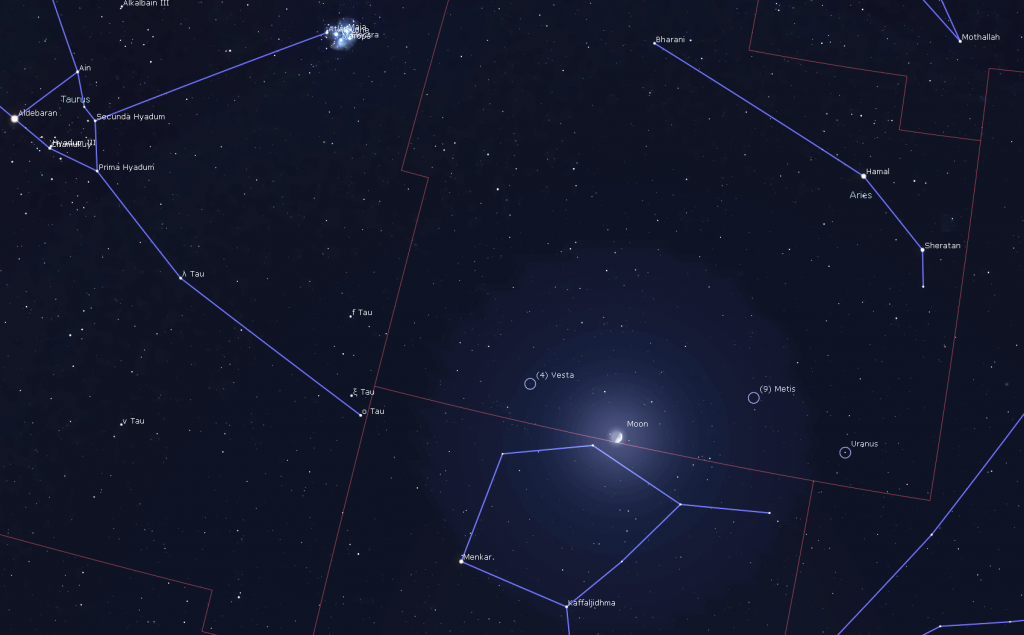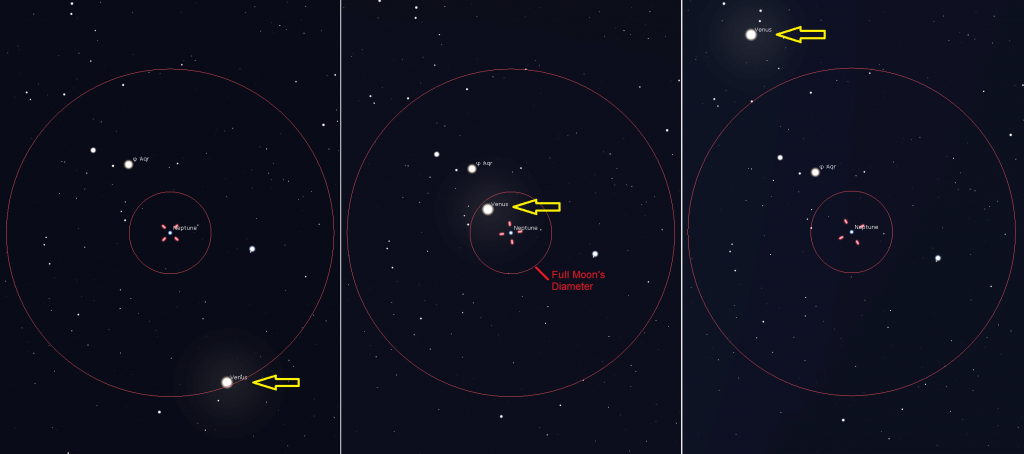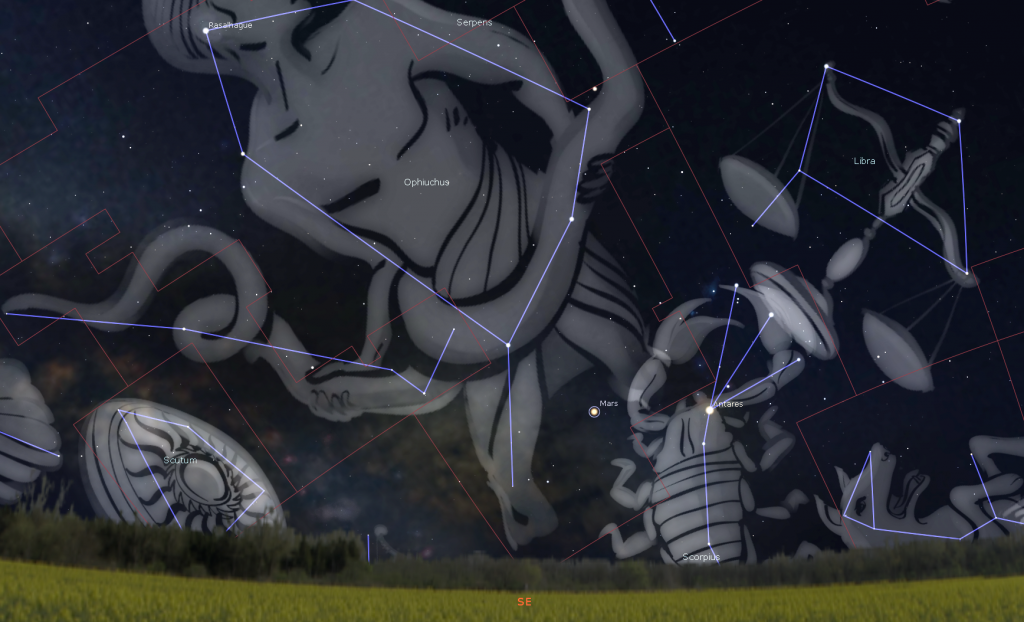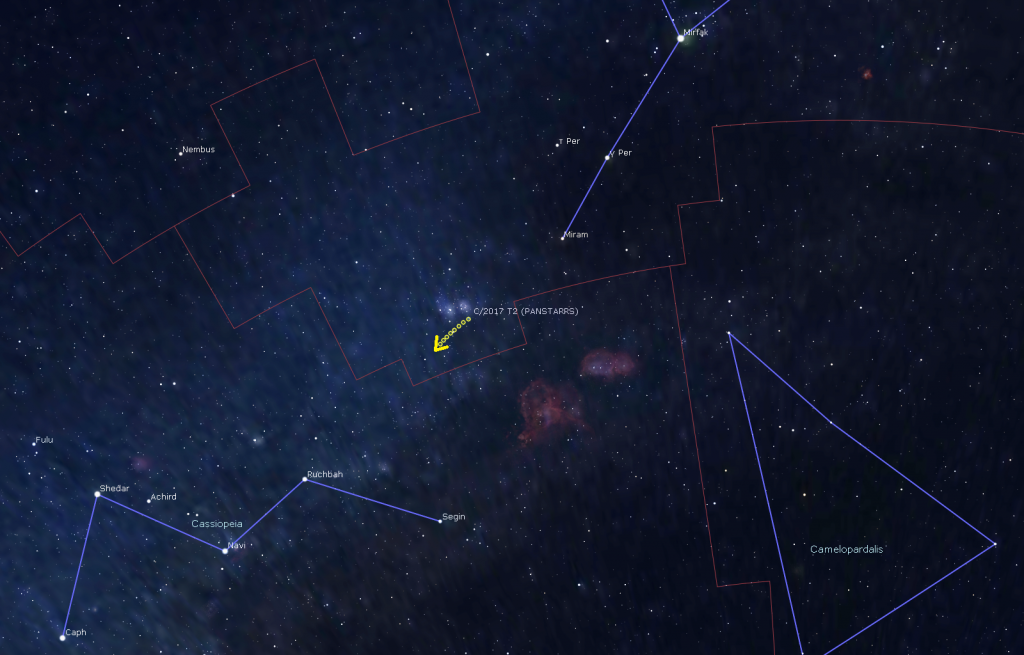A Beautiful Evening Moon, Queen Venus Kisses the Sea-King, and Groundhog Day Marks Mid-Winter!

Valentine’s Day is right around the corner! This beautiful object is called the Rosette Nebula (or NGC 2244). It’s located in the constellation of Monoceros (the Unicorn), just to the left (east) of Orion. The Rosette is a cradle of glowing Hydrogen gas that has birthed about 2500 young stars in its centre. This image was captured through a telescope during November-December, 2019 by Ron Brecher of Guelph, Ontario. His gallery of gorgeous images can be found on his Astrodoc website here.
Hello, End-of-January Stargazers!
Here are your Astronomy Skylights for the week of January 26th, 2020 by Chris Vaughan. Feel free to pass this along to your friends and send me your comments, questions, and suggested topics. I repost these emails with photos at http://astrogeo.ca/skylights/ where all the old editions will be archived. You can also follow me on Twitter as @astrogeoguy! Unless otherwise noted, all times are Eastern Time. To subscribe to these emails please click this MailChimp link.
I can bring my Digital Starlab portable inflatable planetarium to your school or other daytime or evening event. Contact me through AstroGeo.ca, and we’ll tour the Universe together!
The moon will gradually brighten and move to centre stage during evenings the world over this week – so we still have time to seek out the comet in Perseus as it flies past some beautiful clusters and nebulas and take a look at Orion’s treats. After sunset, Queen Venus will kiss distant, blue Neptune in the western sky, with Mercury joining their fun. And Mars will stand beside its rival in the pre-dawn east. Here are your Skylights!
Groundhog Day
Well – Sunday morning, February 2 is Groundhog Day! A cloudy day supposedly forecasts an early spring. But why does it fall on February 2 each year? That date is one of the four so-called cross-quarter days, which are the midpoints between the solstices and equinoxes. February 2 is midway between the winter solstice and the vernal equinox, so we expect the weather to start being more spring-like and less winter-like, whatever the groundhog sees. On February 2, Roman Catholics celebrate Candlemas. In contemporary paganism, the day is called Imbolc, a traditional time for initiations. Astronomers don’t care too much if spring comes early – as long as the skies are clear. The Autumn cross-quarter day occurs at the end of October. I think you can guess which “holiday” that one is.
Well – Sunday morning, February 2 is Groundhog Day! (See what I did there? (wink)
The Moon and Planets
Tonight (Sunday) the young crescent moon will grace the southwestern sky for a short time after sunset, while brilliant Venus blazes away above it. On Monday and Tuesday evening, the moon will pass to the left (or celestial south) of Venus. Both the moon and Venus (viewed through your telescope) will be only partially illuminated because the sun sits west of them both – but Venus will show a more fully-lit disk because it is farther away from Earth than the sun is.
From Wednesday to Friday, the moon will continue to set later and wax in phase while it travels along the southern (lower) border of the faint-ish stars of Pisces (the Fishes). On Friday and Saturday, the nearly half-illuminated moon will pass by dim Uranus. But moonlight does distant Uranus no favours.
The moon will reach its first quarter phase on Saturday evening, February 1 at 8:42 pm EST (or Sunday, February 2 at 01:42 GMT). At first quarter, the relative positions of the Earth, sun, and moon cause us to see the moon half illuminated – on the western (right-hand) side. First quarter moons always rise at noon and set at midnight, so they are visible starting in the afternoon hours. The term “first quarter” refers not to the moon’s appearance, but the fact that our natural satellite has now completed the first quarter of its orbit around Earth, counting from the last new moon.
The ten days or so that are centred on first quarter are the best times to look at the moon under magnification – in binoculars and telescopes of any size. But the nights preceding first quarter are more convenient for us because the moon is already sitting in a dark sky after dinner – for everyone on Earth! The spectacular sights are caused because the sun’s light is striking the moon at a shallow angle along the pole-to-pole terminator line that separates the lit and dark hemispheres. With no atmosphere to scatter light, the shadows cast by every crater rim and mountain ridge are a deep black – and even very small bumps and ridges are highlighted, revealing otherwise hidden features on crater floors.

By the way, the ring of stars sitting just below the moon on Saturday night forms the head of Cetus (the Sea-Monster). The brightest star in the ring, named Menkar, will be positioned less that a fist’s diameter to the lower left (or 8 degrees to the celestial south) of the moon. Take note of those stars and look for the asteroid Vesta and the planet Uranus on a night when the moon has left the area. I’ll post a chart showing where those two objects are here.

Mercury is in the early days of a fantastic evening appearance for equatorial and Northern Hemisphere observers. It will reach peak visibility on February 10 – but you can hunt for already. Look just above the west-southwestern horizon right after sunset. Mercury will climb higher every day, so keep trying every clear evening. The optimal viewing time will be about ten minutes on either side of 6 pm local time. Mercury can be easily seen with unaided eyes in a cloud-free sky. If you use binoculars to hunt for Mercury, make sure that the sun has already completely sunk out of sight.
As I previously mentioned, Venus is definitely the queen of the night this winter. She’ll hold court in the western evening sky until spring. This week, Venus will shine at a brilliant magnitude -4.1, and from Sunday to Tuesday, she’ll be your guide to seeing the dimmest and remote planet of our solar system – Neptune.
Along with the stars surrounding it, Neptune is carried towards the sun little-by-little every night. That motion, which is caused by the Earth’s orbit around the sun, causes objects to set about 4 minutes earlier every night. Meanwhile, Venus’ own orbit has been moving it farther from the sun in the sky – and directly towards Neptune. This week, they’ll kiss as they pass one another – and the whole world can witness it in the western sky after dusk!

On Monday, January 27, Venus will pass so close to Neptune (there will be only 9 arc-minutes between them – for comparison, the moon is 30 arc-minutes across) that the two planets will easily fit into the field of view of a backyard telescope at high magnification. On Sunday and Tuesday though, the two planets will sit about one finger’s width apart – so you’ll need to zoom out to a lower magnification to keep both of them visible at the same time through your telescope.
On Sunday, blue Neptune will sit between Venus (below) and a golden star named Phi (φ) Aquarii (above). On Monday, Venus will climb to sit between Neptune and the golden star, but much closer to Neptune. Then on Tuesday, Venus will jump above Phi Aquarii, putting the golden star in the middle. Venus’ brilliance will all but overwhelm dim Neptune – so you may need to try putting Venus just beyond your eyepiece’s round field of view and looking for the dim, blue dot of Neptune. Another tip: planet Neptune won’t flicker or twinkle much at all – but the stars will. Remember that most telescopes flip and/or invert the view. I’ll post an un-flipped view of them here.
Venus and Neptune will set in the west at about 8: 30 pm local time. Try to catch Neptune right after dark, when it is highest in the sky – and you will be viewing through less of Earth’s distorting atmosphere. Neptune will remain near Phi Aquarii after Venus has moved off.
The only other observable evening planet nowadays is Uranus. The blue-green, remote planet is observable from dusk until about midnight (it sets at about 12:45 am local time). It is located a generous palm’s width above (or 7° to the celestial east of) the modest stars that form the V-shaped constellation of Pisces (the Fishes). Uranus is actually located within the boundary of Aries (the Ram) – and is positioned below (or to the celestial south of) that constellation’s brightest stars, Sheratan (the lower, more westerly star) and Hamal (the higher, more easterly star). The planet is also a fist’s diameter to the upper right of the ring of stars that form the head of Cetus (the Sea-Monster).

Shining at magnitude 5.8, Uranus is bright enough to see under dark sky conditions with unaided eyes and with binoculars – or through small telescopes under less-dark conditions. If you view Uranus after about 6:15 pm local time, it will be higher, in the dark, southern sky – and you’ll be looking through the least amount of Earth’s disturbing atmosphere. The main belt asteroid Vesta is near Uranus – just above the Sea-Monster’s head. Use binoculars to look for that magnitude 7.9 object.
Mars is now starting to ramp up in brightness ahead of October’s big showing. The red planet will continue to shine in the southeastern pre-dawn sky this week, where it will remain for months to come as Earth moves towards it. This week, Mars will rise at about 4:20 am local time and remain visible until dawn. The relative positions and combined orbital motions of Earth and Mars are causing Mars to appear in roughly the same place in the sky at the same time every morning. However, the planet is actually moving rapidly eastward in front of the distant background stars because they rise four minutes earlier every morning – while Mars does not.

This week, Mars will sit in Ophiuchus (the Snake-Bearer), a generous palm’s width to the left (celestial east) of its stellar rival, the bright, ruddy-tinted star Antares. That star marks the heart of Scorpius (the Scorpion).
Awesome Orion
The moon won’t be too bright to stop us from seeing deep sky objects this week, so if you missed last week’s tour of Orion (the Hunter), I posted sky charts and photos of the best objects here.
Binocular Comet Update
A relatively modest comet is traversing the northeastern evening sky this winter – and this week’s young, waxing moon will allow observers in the Northern Hemisphere to continue watching it. The comet is named C/2017 T2 (PanSTARRS), after the robotic telescope that discovered it. It is currently shining at about magnitude 9 – well within reach of medium or large binoculars and backyard telescopes. It is conveniently positioned in the sky for evening viewing. It’s very high in the northern sky after dusk – and then it drops lower in mid-evening as the Earth’s rotation carries the northwestern sky lower.
During the week, the comet will remain just inside the northern boundary of Perseus (the Hero). If you face north, the comet will be positioned a generous fist’s diameter to the lower left of the very bright star Mirfak in Perseus, and a generous palm’s width to the upper right (or 7.5° to the celestial northwest) of the medium-bright star Ruchbah in Cassiopeia (the Queen). Ruchbah marks the top of the shorter peak of Cassiopeia’s “M”-shape.
Comets move past the background stars faster than the planets do. Over the next seven nights Comet C/2017 T2 Panstarrs will shift by about one finger’s width of sky, directly towards Ruchbah in Cassiopeia.

This week, the comet will continue to sit less than a finger’s width (0.5°) below the famous Double Cluster. That close-together pair of star clusters is visible to unaided eyes under dark skies and is very easy to see in binoculars from the city – making finding the comet very easy to find. Look for the comet just to the lower left of those two patches of stars. For astrophotographers, the pretty Heart and Soul Nebulas will still sit about 4 degrees to the lower right of the comet.
When viewed in binoculars and telescopes, Comet PanSTARRS will appear as a dim, fuzzy patch that might exhibit a faint greenish centre. Its modest tail should point roughly away from the Double Cluster. Let me know if you see the comet and if you see a tail! This comet is expected to brighten much more in the coming months. Stay tuned for updates!
Public Astro-Themed Events
Taking advantage of the moon and bright planets in the sky this week, the RASC Toronto Centre astronomers will hold their free monthly public City Sky Star Party in Bayview Village Park (steps from the Bayview subway station), starting around 8 pm on the first clear weeknight this week (Mon, Tues, and Thu only). You don’t need to be an RASC member, or own any equipment, to join them – looks are free! Check here for details, and check the banner on their website home page or Facebook page for the GO or NO-GO decision around 5 pm each day.
Every Monday evening, York University’s Allan I. Carswell Observatory runs an online star party – broadcasting views from four telescopes/cameras, answering viewer questions, and taking requests! Details are here. On Wednesday nights they offer free public viewing through their rooftop telescopes, including their brand new 1-metre telescope! If it’s cloudy, the astronomers give tours and presentations. Registration and details are here.
At 7:30 pm on Wednesday, January 29, the RASC Toronto Centre will hold their free monthly Recreational Astronomy Night Meeting at the Ontario Science Centre, and the public are welcome. Talks include The Sky This Month, stargazing in New Mexico, and more. These meetings are also streamed live on RASC-TC’s YouTube channel. Check here for details. Parking is free.
On Wednesday, January 29 at U of T’s Lash Miller Chemical Laboratories on George St., U of T’s Astronomy and Space Exploration Society (ASX) will present Professor Christopher Matzner discussing Black Holes. Details are here.
If it’s sunny on Saturday morning, February 1 from 10 am to noon, astronomers from the RASC Toronto Centre will be setting up outside the main doors of the Ontario Science Centre for Solar Observing. Come and see the Sun in detail through special equipment designed to view it safely. This is a free event (details here), but parking and admission fees inside the Science Centre will still apply. Check the RASC Toronto Centre website or their Facebook page for the Go or No-Go notification.
On Saturday night, February 1 from 6 to 8 pm, if skies are clear, the Ontario Science Centre will host a free public star party outside on the Teluscape (regular parking fees apply). Details are here.
This winter, spend a Sunday afternoon in the other dome at the David Dunlap Observatory! On Sunday, February 9, from noon to 4 pm, join me in my Starlab Digital Planetarium for an interactive journey through the Universe at DDO. We’ll tour the night sky and see close-up views of galaxies, nebulas, and star clusters, view our Solar System’s planets and alien exo-planets, land on the moon, Mars – and the Sun, travel home to Earth from the edge of the Universe, hear indigenous starlore, and watch immersive fulldome movies! Ask me your burning questions, and see the answers in a planetarium setting – or sit back and soak it all in. Sessions run continuously between noon and 2 pm, and repeat from 2 to 4 pm. Ticket-holders may arrive any time during the program. The program is suitable for ages 3 and older. The Starlab planetarium is wheelchair accessible, but everyone else sits at floor level. For tickets, please use this link. Tickets for future dates will be available soon.
Keep looking up, and enjoy the sky when you do. I love questions and requests – so, send me some!